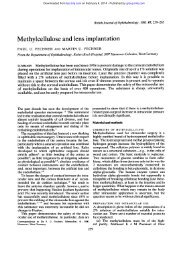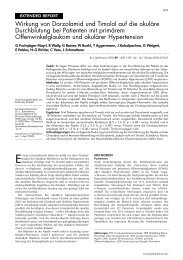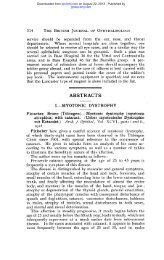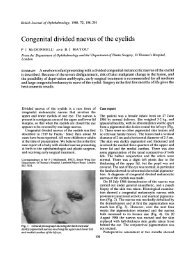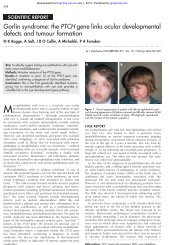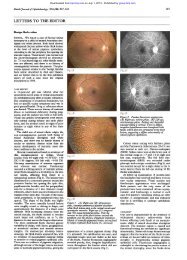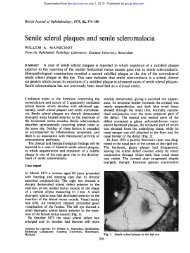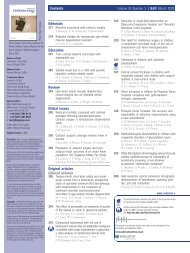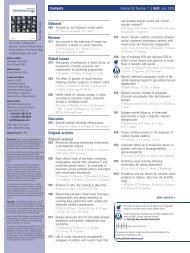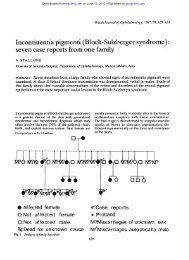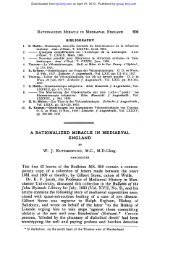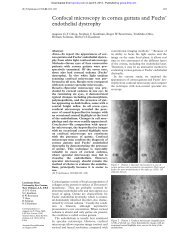Weaning children with accommodative esotropia out of spectacles: a ...
Weaning children with accommodative esotropia out of spectacles: a ...
Weaning children with accommodative esotropia out of spectacles: a ...
You also want an ePaper? Increase the reach of your titles
YUMPU automatically turns print PDFs into web optimized ePapers that Google loves.
Downloaded from<br />
bjo.bmj.com on March 29, 2013 - Published by group.bmj.com<br />
<strong>Weaning</strong> <strong>children</strong> <strong>with</strong> <strong>accommodative</strong> <strong>esotropia</strong> <strong>out</strong> <strong>of</strong> <strong>spectacles</strong> 7<br />
from <strong>spectacles</strong>. Wilson and coworkers 14 have shown that binocularity<br />
is an important factor in helping <strong>accommodative</strong><br />
esotropes maintain their ocular alignment. Since we excluded<br />
patients from the present study who lacked binocularity we<br />
could not evaluate the role <strong>of</strong> binocularity in successfully<br />
weaning <strong>accommodative</strong> esotropes <strong>out</strong> <strong>of</strong> <strong>spectacles</strong>.<br />
ACKNOWLEDGEMENTS<br />
This research was supported in part by a Research to Prevent<br />
Blindness, Inc Lew Wasserman Award (SRL) and by a Research to<br />
Prevent Blindness unrestricted departmental grant (KAH). Presented<br />
in part at the Annual Meeting <strong>of</strong> the Association for Research and<br />
Vision in Ophthalmology, Ft Lauderdale, FL, USA, May 1999.<br />
.....................<br />
Authors’ affiliations<br />
K A Hutcheson, N J Ellish, Department <strong>of</strong> Ophthalmology, University <strong>of</strong><br />
Maryland School <strong>of</strong> Medicine, Baltimore, MD, USA<br />
S R Lambert, Emory Eye Center, Emory University, Atlanta, GA, USA<br />
REFERENCES<br />
1 Raab EL, Spierer A. Persisting <strong>accommodative</strong> <strong>esotropia</strong>. Arch<br />
Ophthalmol 1986;104:1777–9.<br />
2 Repka MX, Wellish K, Wisnicki HJ, et al. Changes in the refractive error<br />
<strong>of</strong> 94 spectacle-treated patients <strong>with</strong> acquired <strong>accommodative</strong> <strong>esotropia</strong>.<br />
Binoc Vis 1989;4:5–21.<br />
New BJO online submission and review system<br />
3 Swan KC. Accommodative <strong>esotropia</strong> long range follow-up.<br />
Ophthalmology 1983;90:1141–5.<br />
4 Taylor RH, Armitage IM, Burke JP. Fully <strong>accommodative</strong> <strong>esotropia</strong> in<br />
adolescence. Br Orthopt J 1995;52:25–8.<br />
5 Rutstein RP, Marxh-Tootle W. Clinical course <strong>of</strong> <strong>accommodative</strong><br />
<strong>esotropia</strong>. Optom Vis Sci 1998;75:97–102.<br />
6 Raab E. Etiologic factors in <strong>accommodative</strong> esodeviation. Trans Am<br />
Ophthalmol Soc 1982;80:657–94.<br />
7 Kobuta N, Akatsu S. Long-term follow-up <strong>of</strong> refractive <strong>accommodative</strong><br />
<strong>esotropia</strong>. In: Campos EC, ed. Strabismus and ocular motility disorders.<br />
London: Macmillan Press, 1990:315–18.<br />
8 Ingram RM, Gill LE, Lambert TW. Effect <strong>of</strong> <strong>spectacles</strong> on changes <strong>of</strong><br />
spherical hypermetropia in infants who did, and did not, have<br />
strabismus. Br J Ophthalmol 2000;84:324–6.<br />
9 Smith EL, Hung LF. The role <strong>of</strong> optical defocus in regulating refractive<br />
development in infant monkeys. Vis Res 1999;39:1415–35.<br />
10 Goss DA, Wickham MG. Retinal-image mediated ocular growth as a<br />
mechanism for juvenile onset myopia and for emmetropization. Doc<br />
Ophthalmol 1995;90:341–75.<br />
11 Smith EL, Hung LF, Harwerth RS. Effects <strong>of</strong> optically induced blur on the<br />
refractive status <strong>of</strong> young monkeys. Vis Res 1994;34:293–301.<br />
12 Fujikado T, Kawasaki Y, Suzuki A, et al. Retinal function <strong>with</strong><br />
lens-induced myopia compared <strong>with</strong> form-deprivation myopia in chicks.<br />
Graefes Arch Clin Exp Ophthalmol 1997;235:320–4.<br />
13 Troilo D, Wallman J. The regulation <strong>of</strong> eye growth and refractive<br />
state: an experimental study <strong>of</strong> emmetropization. Vis Res<br />
1991;31:1237–50.<br />
14 Wilson ME, Bluestein EC, Parks MM. Binocularity in <strong>accommodative</strong><br />
<strong>esotropia</strong>. J Pediatr Ophthalmol Strabismus 1993;30:233–6.<br />
The Editors <strong>of</strong> British Journal <strong>of</strong> Opthalmology are pleased to inform authors and reviewers<br />
<strong>of</strong> its new online submission and review system. Bench>Press is a fully integrated electronic<br />
system which uses the internet to allow rapid and efficient submission <strong>of</strong><br />
manuscripts, as well as the entire peer review process to be conducted online.<br />
Authors can submit their manuscript in any standard word processing s<strong>of</strong>tware. Graphic<br />
formats acceptable are: .jpg, .tiff, .gif, and eps. (Nb. Multipage PowerPoint presentations<br />
are NOT acceptable.) Text and graphic files are automatically converted to PDF for ease<br />
<strong>of</strong> distribution and reviewing purposes. Authors are asked to approve their submission<br />
before it formally enters the reviewing process.<br />
To access the system click on “SUBMIT YOUR MANUSCRIPT HERE” on the BJO<br />
homepage: http://www.bjopthalmol.com/, or you can access Bench>Press directly at<br />
http://submit-bjo.bmjjournals.com/.<br />
We are very excited <strong>with</strong> this new development, it really is simple to use and should be a<br />
big improvement on the current peer review process. Full instructions can be found on<br />
Bench>Press and BJO online. Please contact Natalie Davies, Project Manager,<br />
ndavies@bmjgroup.com for further information.<br />
Pre-register<br />
We would be grateful if all British Journal <strong>of</strong> Opthalmology authors and reviewers<br />
pre-registered <strong>with</strong> the system. This will give you the opportunity to update your contact<br />
and expertise data, allowing us to provide you <strong>with</strong> a more efficient service.<br />
Instructions For Registering<br />
1. Enter http://submit-bjo.bmjjournals.com<br />
2. Click on “Create a New Account” in the upper left hand side <strong>of</strong> the Bench>Press<br />
homepage.<br />
3. Enter your email address in the space provided.<br />
4. Choose a password for yourself and enter it in the spaces provided.<br />
5. Complete the question <strong>of</strong> your choice to be used in the event you cannot remember your<br />
password at a later time.<br />
6. Click on the “Save” button at the bottom <strong>of</strong> the screen.<br />
7. Check the email account you registered under. An email will be sent to you <strong>with</strong> a verification<br />
number and URL.<br />
8. Once you receive this verification number, click on the URL hyperlink and enter the verification<br />
number in the relevant field. This is for security reasons and to check that your account is<br />
not being used fraudulently.<br />
9. Enter/amend your contact information, and update your expertise data.<br />
10. Please note: You only need to create a new account once. If you submit to another<br />
BMJ Publishing Group journal you can use the same email address and password<br />
www.bjophthalmol.com



